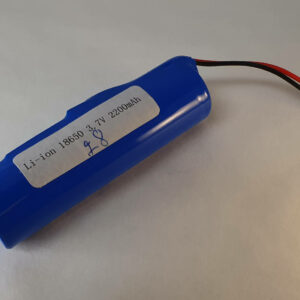Description
This is a battery for which international shipping restriction apply. For this reason shipping is restricted to EU countries and a limited set of shipping carriers. See our shipping information page for more details.
These are our go-to cells when we need a reliable power source: they are made by a reputable Chinese cell manufacturer and have proven their strength to us many, many times. They are truly good lithium ion batteries!
Features
- True 2600mAh capacity lithium ion cell
- 40mm wire with JST-PH 2 pin connector
- Dimensions (Ø x H): 18x65mm
- Nominal voltage: 3.6V
- Charge termination target: 4.2V
- Typical charge current: 0.5C
- Max. charge current 1C
- Weight: ~47g
- Max. discharge current: 1.5C
- Has your back covered / Built-in protection:
- Over-discharge threshold: 2.5V
- Over-charge threshold: 4.3V
- Over-current threshold: 5A
What can I do with one of these batteries?
Lithium ion and lithium polymer batteries are currently the most used batteries in rechargeable consumer electronic products. Your smartphone contains one, as do notebooks and many electric cars. What we mean is that your imagination is probably the limit.
The thing to know however is that you will probably need some additional circuitry to be able to use a lithium battery with your projects.
First and foremost, you’ll need some mean of charging the battery (see the note on that below).
Secondly, you’ll probably need to do some voltage conversion, as lithium batteries have a fairly wide usable voltage range. This very cell will have about 4.2V when fully charged, and can be depleted down to 2.5V without taking damage.
Many of the boards you’ll want to connect require a fixed (and ideally stable) voltage, which means you’ll have to add some conversion:
- the easiest one is if you need a fixed voltage that is higher (or lower) than the usable range of the battery. You’ll be able to use a buck or a boost converter
- if you need an output voltage which is inside the range, you’ll want either:
- a SEPIC converter (which can do seamless step-up and step-down conversion)
- or to chain a boost with a buck converter or a linear regulator
If that all sound terribly complicated for you, why don’t you give our PGCPSU DUO a try? It does all the above for you in a tiny package, plus it has the right connector, making this a true plug&play experience!
How we test batteries
We’re using this very cell in the Luccia nightlight! As one of our top priorities was to build a reliable and long-lasting product we selected all components very carefully. For the battery we tested not only for capacity, but also for self discharge as well as all expected fault conditions. As you might guess these cells passed our testing with flying colors.
- On average we measured +3.5% capacity deviation (at 0.5C discharge rate, 1C charge rate, 10 cycles)
- Self discharge was very limited (average: 4.1382V after 90 days, starting from average 4,1638V with 30 cells tested)
- Durable: we have a long-run test still going on (August ’19, started April ’18), showing ~2300mAh capacity left after 623 cycles

On charging Lithium Ion Batteries
Lithium batteries require a so-called CC/CV (“constant current”/”constant voltage”) charge cycle. Typically you’ll want to use a specialized charging circuit such as our PGCPSU boards to avoid issues.
Please note that charging the batteries in an unsafe way can be dangerous and cause fire or injury! Take precautions as necessary!





Reviews
There are no reviews yet.